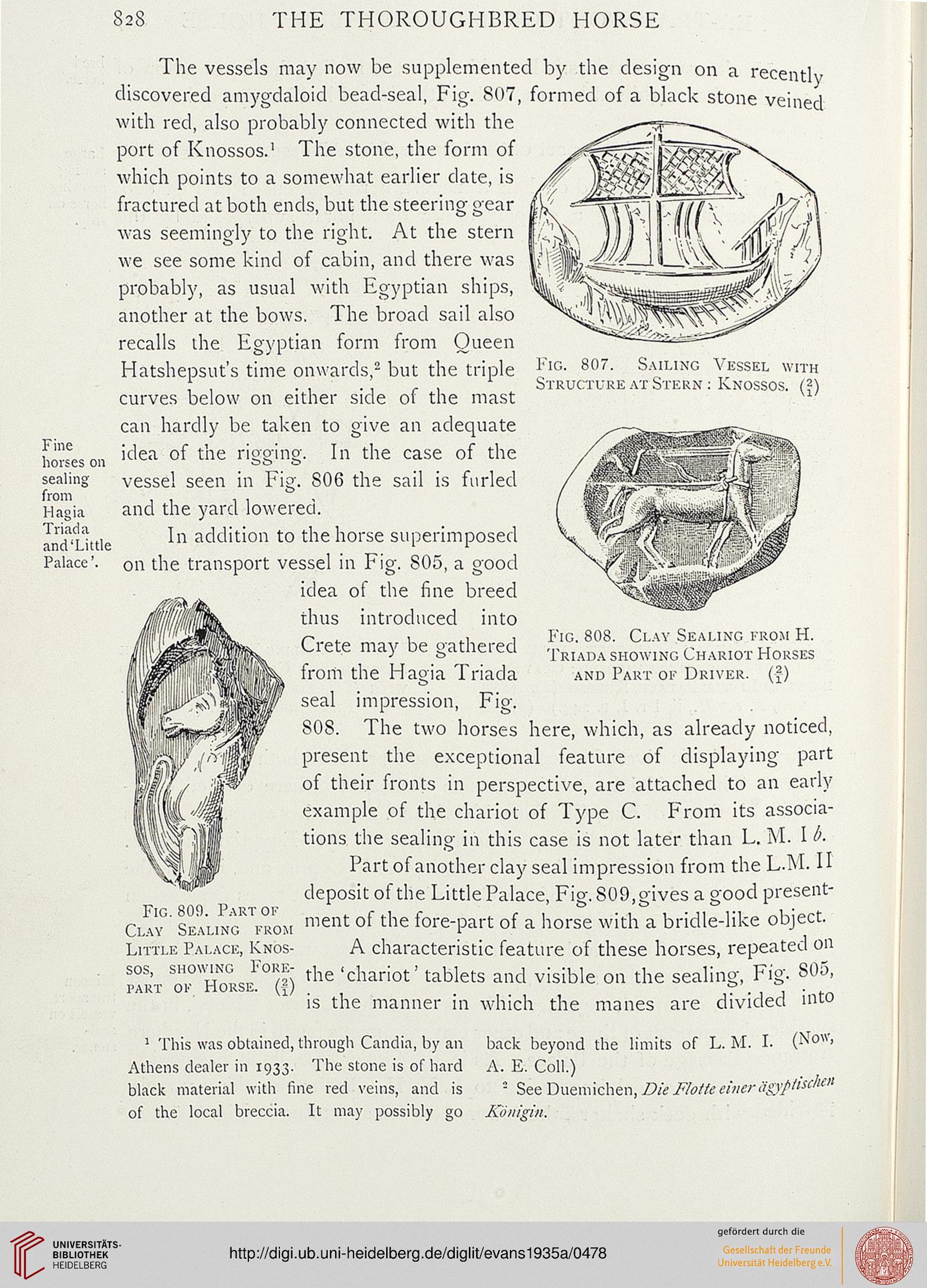828
THE THOROUGHBRED HORSE
Fig. 807. Sailing Vessel with
Structure at Stern : Knossos. (I)
Fine
horses on
sealing"
from
Hagia
Triad a
and'Little
Palace'.
The vessels may now be supplemented by the design on a recently
discovered amygdaloid bead-seal, Fig. 807, formed of a black stone veined
with red, also probably connected with the
port of Knossos." The stone, the form of
which points to a somewhat earlier date, is
fractured at both ends, but the steering gear
was seemingly to the right. At the stern
we see some kind of cabin, and there was
probably, as usual with Egyptian ships,
another at the bows. The broad sail also
recalls the Egyptian form from Queen
Hatshepsut's time onwards,2 but the triple
curves below on either side of the mast
can hardly be taken to give an adequate
idea of the rigging. In the case of the
vessel seen in Fig. 806 the sail is furled
and the yard lowered.
In addition to the horse superimposed
on the transport vessel in Fig. 805, a good
idea of the fine breed
thus introduced into
Crete may be gathered
from the Hagia Triada
seal impression, Fig.
SOS. The two horses here, which, as already noticed,
present the exceptional feature of displaying part
of their fronts in perspective, are attached to an early
example of the chariot of Type C. From its associa-
tions the sealing in this case is not later than L. M. I !>■
Part of another clay seal impression from the L.M. 11
deposit of the Little Palace, Fig. 809,gives a good present-
ment of the fore-part of a horse with a bridle-like object.
A characteristic feature of these horses, repeated on
the 'chariot' tablets and visible on the sealing, Fig. 80o,
is the manner in which the manes are divided into
I
Fig. 808. Clay Sealing from H.
Triada showing Chariot Horses
and Part of Driver, (f)
Fig. 809. Part of
Clay Sealing from
Little Palace, Knos-
sos, showing Fore-
part of Horse. (?)
1 This was obtained, through Candia, by an
Athens dealer in 1933. The stone is of hard
black material with fine red veins, and is
of the local breccia. It may possibly go
back beyond the limits of L. M. I. (No"''
A. E. Coll.)
- See Duerhichen, Die Flotte einer ag)'fhs'hc"
Konigin.
THE THOROUGHBRED HORSE
Fig. 807. Sailing Vessel with
Structure at Stern : Knossos. (I)
Fine
horses on
sealing"
from
Hagia
Triad a
and'Little
Palace'.
The vessels may now be supplemented by the design on a recently
discovered amygdaloid bead-seal, Fig. 807, formed of a black stone veined
with red, also probably connected with the
port of Knossos." The stone, the form of
which points to a somewhat earlier date, is
fractured at both ends, but the steering gear
was seemingly to the right. At the stern
we see some kind of cabin, and there was
probably, as usual with Egyptian ships,
another at the bows. The broad sail also
recalls the Egyptian form from Queen
Hatshepsut's time onwards,2 but the triple
curves below on either side of the mast
can hardly be taken to give an adequate
idea of the rigging. In the case of the
vessel seen in Fig. 806 the sail is furled
and the yard lowered.
In addition to the horse superimposed
on the transport vessel in Fig. 805, a good
idea of the fine breed
thus introduced into
Crete may be gathered
from the Hagia Triada
seal impression, Fig.
SOS. The two horses here, which, as already noticed,
present the exceptional feature of displaying part
of their fronts in perspective, are attached to an early
example of the chariot of Type C. From its associa-
tions the sealing in this case is not later than L. M. I !>■
Part of another clay seal impression from the L.M. 11
deposit of the Little Palace, Fig. 809,gives a good present-
ment of the fore-part of a horse with a bridle-like object.
A characteristic feature of these horses, repeated on
the 'chariot' tablets and visible on the sealing, Fig. 80o,
is the manner in which the manes are divided into
I
Fig. 808. Clay Sealing from H.
Triada showing Chariot Horses
and Part of Driver, (f)
Fig. 809. Part of
Clay Sealing from
Little Palace, Knos-
sos, showing Fore-
part of Horse. (?)
1 This was obtained, through Candia, by an
Athens dealer in 1933. The stone is of hard
black material with fine red veins, and is
of the local breccia. It may possibly go
back beyond the limits of L. M. I. (No"''
A. E. Coll.)
- See Duerhichen, Die Flotte einer ag)'fhs'hc"
Konigin.





